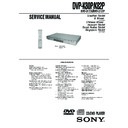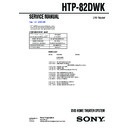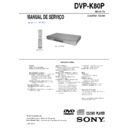Sony DVP-K80P / DVP-K82P Service Manual ▷ View online
CD/DVD PLAYER
System
Laser: Semiconductor laser
Signal format system: PAL/NTSC
Laser: Semiconductor laser
Signal format system: PAL/NTSC
(See page 16 to switch)
Audio characteristics
Frequency response: DVD VIDEO (PCM
Frequency response: DVD VIDEO (PCM
96 kHz): 2 Hz to 44 kHz (±1.0 dB)/
DVD VIDEO (PCM 48 kHz): 2 Hz to
22 kHz (±0.5 dB)/CD: 2 Hz to 20 kHz
(±0.5 dB)
DVD VIDEO (PCM 48 kHz): 2 Hz to
22 kHz (±0.5 dB)/CD: 2 Hz to 20 kHz
(±0.5 dB)
Signal-to-noise ratio (S/N ratio): 115 dB
(LINE OUT L/R (AUDIO) jacks only)
Harmonic distortion: 0.003%
Dynamic range: DVD VIDEO: 103 dB/CD:
Dynamic range: DVD VIDEO: 103 dB/CD:
99 dB
Wow and flutter: Less than detected value
(±0.001% W PEAK)
Outputs and Input
(Jack name: Jack type/Output level/
(Jack name: Jack type/Output level/
Load impedance)
LINE OUT (AUDIO): Phono jack/
2 Vrms/ 10 kilohms
DIGITAL OUT (OPTICAL):
Optical output jack/-18 dBm
(wave length: 660 nm)
(wave length: 660 nm)
DIGITAL OUT (COAXIAL): Phono jack/
0.5 Vp-p/75 ohms
COMPONENT VIDEO OUT (K82P)
(Y, P
B
/C
B
, P
R
/C
R
): Phono jack/
Y: 1.0 Vp-p, P
B
/C
B
,
P
R
/C
R
: 0.7 Vp-p/75 ohms
COMPONENT VIDEO OUT
(Y, P
B
, P
R
) (K80P)
Phono jack/Y: 1.0 Vp-p/P
B
, P
R
:
interlace
*1
= 0.648 Vp-p, progressive or
interlace
*2
= 0.7 Vp-p/75 ohms
*1
BLACK LEVEL
(COMPONENT OUT) is ON
(COMPONENT OUT) is ON
*2
BLACK LEVEL
(COMPONENT OUT) is OFF
(COMPONENT OUT) is OFF
LINE OUT (VIDEO): Phono jack/
1.0 Vp-p/75 ohms
SPECIFICATIONS
S VIDEO OUT: 4-pin mini DIN/
Y: 1.0 Vp-p, C: 0.3 Vp-p (PAL),
0.286 Vp-p (NTSC)/75 ohms
0.286 Vp-p (NTSC)/75 ohms
MIC input 1/2: Phone jacks
General
Power requirements:
Power requirements:
110–240 V AC, 50/60 Hz
(Except K82P: RUS)
220–240 V AC, 50/60 Hz
(K82P: RUS)
(Except K82P: RUS)
220–240 V AC, 50/60 Hz
(K82P: RUS)
Power consumption: 11 W
Dimensions (approx.):
Dimensions (approx.):
430
× 55.5 × 243.7 mm
(width/height/depth)
incl. projecting parts
incl. projecting parts
Mass (approx.): 2.04 kg
Operating temperature: 5°C to 35°C
Operating humidity: 25% to 80%
Operating temperature: 5°C to 35°C
Operating humidity: 25% to 80%
Supplied accessories
See page 14.
See page 14.
Specifications and design are subject to
change without notice.
change without notice.
Photo : DVP-K82P
RMT-D177P
DVP-K80P/K82P
RMT-D177A/RMT-D177P
SERVICE MANUAL
Brazilian Model
E Model
DVP-K80P
Chin
ese Model
Russian Model
Saudi Arabia Model
Singapore Model
DVP-K82P
– 2 –
DVP-K80P/K82P
SAFETY CHECK-OUT
1. Check the area of your repair for unsoldered or poorly-soldered
connections. Check the entire board surface for solder splashes
and bridges.
and bridges.
2. Check the interboard wiring to ensure that no wires are “pinched”
or contact high-wattage resistors.
3. Look for unauthorized replacement parts, particularly transis-
tors, that were installed during a previous repair. Point them out
to the customer and recommend their replacement.
to the customer and recommend their replacement.
4. Look for parts which, though functioning, show obvious signs
of deterioration. Point them out to the customer and recommend
their replacement.
their replacement.
5. Check the line cord for cracks and abrasion.
Recommend the replacement of any such line cord to the cus-
tomer.
tomer.
6. Check the B+ voltage to see it is at the values specified.
7. Check the antenna terminals, metal trim, “metallized” knobs,
screws, and all other exposed metal parts for AC leakage. Check
leakage as described below.
leakage as described below.
WARNING!!
WHEN SERVICING, DO NOT APPROACH THE LASER EXIT
WITH THE EYE TOO CLOSELY. IN CASE IT IS NECESSARY TO
CONFIRM LASER BEAM EMISSION, BE SURE TO OBSERVE
FROM A DISTANCE OF MORE THAN 25 cm FROM THE SURFACE
OF THE OBJECTIVE LENS ON THE OPTICAL PICK-UP BLOCK.
WITH THE EYE TOO CLOSELY. IN CASE IT IS NECESSARY TO
CONFIRM LASER BEAM EMISSION, BE SURE TO OBSERVE
FROM A DISTANCE OF MORE THAN 25 cm FROM THE SURFACE
OF THE OBJECTIVE LENS ON THE OPTICAL PICK-UP BLOCK.
CAUTION:
The use of optical instrument with this product will increase eye
hazard.
The use of optical instrument with this product will increase eye
hazard.
CAUTION
Use of controls or adjustments or performance of procedures
other than those specified herein may result in hazardous radiation
exposure.
Use of controls or adjustments or performance of procedures
other than those specified herein may result in hazardous radiation
exposure.
SAFETY-RELATED COMPONENT WARNING!!
COMPONENTS IDENTIFIED BY MARK
OR DOTTED LINE
WITH MARK
ON THE SCHEMATIC DIAGRAMS AND IN
THE PARTS LIST ARE CRITICAL TO SAFE OPERATION.
REPLACE THESE COMPONENTS WITH SONY PARTS
WHOSE PART NUMBERS APPEAR AS SHOWN IN THIS
MANUAL OR IN SUPPLEMENTS PUBLISHED BY SONY.
REPLACE THESE COMPONENTS WITH SONY PARTS
WHOSE PART NUMBERS APPEAR AS SHOWN IN THIS
MANUAL OR IN SUPPLEMENTS PUBLISHED BY SONY.
After correcting the original service problem, perform the following
safety checks before releasing the set to the customer:
safety checks before releasing the set to the customer:
LEAKAGE TEST
The AC leakage from any exposed metal part to earth ground and
from all exposed metal parts to any exposed metal part having a
return to chassis, must not exceed 0.5mA (500 microampers).
Leakage current can be measured by any one of three methods.
The AC leakage from any exposed metal part to earth ground and
from all exposed metal parts to any exposed metal part having a
return to chassis, must not exceed 0.5mA (500 microampers).
Leakage current can be measured by any one of three methods.
1. A commercial leakage tester, such as the Simpson 229 or RCA
TW-540A. Follow the manufacturers’ instructions to use these
instruments.
instruments.
2. A battery-operated AC milliammeter. The Data Precision 245
digital multimeter is suitable for this job.
3. Measuring the voltage drop across a resistor by means of a
VOM or battery-operated AC volmeter. The “limit” indication
is 0.75V, so analog meters must have an accurate low voltage
scale. The Simpson 250 and Sanwa SH-63Trd are examples of
a passive VOM that is suitable. Nearly all battery operated
digital multimeters that have a 2V AC range are suitable. (See
Fig. A)
is 0.75V, so analog meters must have an accurate low voltage
scale. The Simpson 250 and Sanwa SH-63Trd are examples of
a passive VOM that is suitable. Nearly all battery operated
digital multimeters that have a 2V AC range are suitable. (See
Fig. A)
Unleaded solder
Boards requiring use of unleaded solder are printed with the lead-
free mark (LF) indicating the solder contains no lead.
(Caution: Some printed circuit boards may not come printed with
the lead free mark due to their particular size.)
Boards requiring use of unleaded solder are printed with the lead-
free mark (LF) indicating the solder contains no lead.
(Caution: Some printed circuit boards may not come printed with
the lead free mark due to their particular size.)
: LEAD FREE MARK
Unleaded solder has the following characteristics.
• Unleaded solder melts at a temperature about 40°C highter than
• Unleaded solder melts at a temperature about 40°C highter than
ordinary solder.
Ordinary soldering irons can be used but the iron tip has to be
applied to the solder joint for a slightly longer time.
Soldering irons using a temperature regulator should be set to
about 350°C
Caution: The printed pattern (copper foil) may peel away if the
heated tip is applied for too long, so be careful!
Ordinary soldering irons can be used but the iron tip has to be
applied to the solder joint for a slightly longer time.
Soldering irons using a temperature regulator should be set to
about 350°C
Caution: The printed pattern (copper foil) may peel away if the
heated tip is applied for too long, so be careful!
• Strong viscosity
Unleaded solder is more viscous (sticky, less prone to flow) than
ordinary solder so use caution not to let solder bridges occur such
as on IC pins, etc.
ordinary solder so use caution not to let solder bridges occur such
as on IC pins, etc.
• Usable with ordinary solder
It is best to use only unleaded solder but unleaded solder may also
be added to ordinary solder.
be added to ordinary solder.
To Exposed Metal
Parts on Set
0.15 F
1.5k
AC
Voltmeter
(0.75 V)
Voltmeter
(0.75 V)
Earth Ground
Fig.A. Using an Acvoltmeter to check AC leakage.
– 3 –
DVP-K80P/K82P
TABLE OF CONTENTS
SERVICE NOTE
1.
Disc Removal Procedure (at POWER OFF) .............. 4
1.
GENERAL
Warning .......................................................................... 1-1
Notes about the Discs .................................................. 1-1
Precautions .................................................................... 1-1
About this Manual .......................................................... 1-1
This Player Can Play the Following Discs ................... 1-1
Index to Parts and Controls ......................................... 1-2
Guide to the Control Menu Display .............................. 1-3
Notes about the Discs .................................................. 1-1
Precautions .................................................................... 1-1
About this Manual .......................................................... 1-1
This Player Can Play the Following Discs ................... 1-1
Index to Parts and Controls ......................................... 1-2
Guide to the Control Menu Display .............................. 1-3
Hookups ................................................................................ 1-3
Hooking Up the Player .................................................. 1-3
Step 1: Unpacking ......................................................... 1-3
Step 2: Inserting Batteries into the Remote ................. 1-3
Step 3: Connecting the Video Cords ............................ 1-4
Step 4: Connecting the Audio Cords ............................ 1-4
Step 5: Connecting the Mains Lead ............................. 1-5
Step 6: Quick Setup ...................................................... 1-5
Step 1: Unpacking ......................................................... 1-3
Step 2: Inserting Batteries into the Remote ................. 1-3
Step 3: Connecting the Video Cords ............................ 1-4
Step 4: Connecting the Audio Cords ............................ 1-4
Step 5: Connecting the Mains Lead ............................. 1-5
Step 6: Quick Setup ...................................................... 1-5
Playing Discs ......................................................................... 1-5
Playing Discs ................................................................. 1-5
Resuming Playback from the Point Where You
Resuming Playback from the Point Where You
Stopped the Disc (Multi-disc Resume) .................. 1-6
Using the DVD's Menu .................................................. 1-6
Selecting “ORIGINAL” or “PLAY LIST” on a
Selecting “ORIGINAL” or “PLAY LIST” on a
DVD-RW/DVD-R ....................................................... 1-6
Playing VIDEO CD's With PBC Functions
(PBC Playback) ........................................................ 1-6
Various Play Mode Functions (Program Play,
Shuffle Play, Repeat Play, A-B Repeat Play ........... 1-7
Searching for a Scene .......................................................... 1-8
Searching for a Particular Point on a Disc (Search,
Scan, Slow-motion Play, Freeze Frame) ............... 1-8
Searching for a Title/Chapter/Track/Scene, etc. ......... 1-8
Searching by Scene (PICTURE NAVIGATION) ......... 1-8
Searching by Scene (PICTURE NAVIGATION) ......... 1-8
Enjoying Karaoke .................................................................. 1-9
Using Karaoke ............................................................... 1-9
Changing the Key (Key Control) .................................. 1-9
Playing Karaoke with Any Stereo Disc
Changing the Key (Key Control) .................................. 1-9
Playing Karaoke with Any Stereo Disc
(Karaoke Pon) .......................................................... 1-9
Selecting the Vocals (Vocal Select) .............................. 1-9
Turning the Guide Melody On and Off
Turning the Guide Melody On and Off
(Guide Melody) ......................................................... 1-10
Inserting the Applause Effect (Applause) .................... 1-10
Viewing Information About the Disc ..................................... 1-10
Checking the Playing Time and Remaining Time ........ 1-10
Sound Adjustments ............................................................... 1-11
Changing the Sound ...................................................... 1-11
TV Virtual Surround Settings (TVS) ............................. 1-11
TV Virtual Surround Settings (TVS) ............................. 1-11
Enjoying Movies .................................................................... 1-12
Changing the Angles ..................................................... 1-12
Displaying the Subtitles ................................................. 1-12
Adjusting the Playback Picture
Displaying the Subtitles ................................................. 1-12
Adjusting the Playback Picture
(CUSTOM PICTURE MODE) ................................. 1-12
Sharpening the Pictures (SHARPNESS) ..................... 1-13
Enjoying MP3 Audio and JPEG Images .............................. 1-13
About MP3 Audio Tracks and JPEG Image Files ....... 1-13
Playing MP3 Audio Tracks and JPEG Image Files ..... 1-13
Enjoying JPEG Images as a Slide Show ..................... 1-14
Playing MP3 Audio Tracks and JPEG Image Files ..... 1-13
Enjoying JPEG Images as a Slide Show ..................... 1-14
Enjoying DivX Videos ............................................................ 1-15
About DivX Video Files .................................................. 1-15
Playing DivX Video Files ............................................... 1-15
Playing DivX Video Files ............................................... 1-15
Using Various Additional Functions ...................................... 1-15
Locking Discs (CUSTOM PARENTAL CONTROL,
PARENTAL CONTROL) .......................................... 1-15
Controlling Your TV with the Supplied Remote ............. 1-16
Settings and Adjustments ..................................................... 1-16
Using the Setup Display ............................................... 1-16
Setting the Display or Sound Track Language
Setting the Display or Sound Track Language
(LANGUAGE SETUP) ............................................. 1-17
Settings for the Display (SCREEN SETUP) ................ 1-17
Custom Settings (CUSTOM SETUP) .......................... 1-17
Settings for the Sound (AUDIO SETUP) ..................... 1-17
Custom Settings (CUSTOM SETUP) .......................... 1-17
Settings for the Sound (AUDIO SETUP) ..................... 1-17
Additional Information ............................................................ 1-18
Troubleshooting ............................................................. 1-18
Self-diagnosis Function (When letters/
Self-diagnosis Function (When letters/
numbers appear in the display ................................ 1-19
Glossary ........................................................................ 1-19
Specifications ................................................................. 1-19
Specifications ................................................................. 1-19
2.
DISASSEMBLY
2-1.
Upper Case and Cover Tray ........................................ 2-1
2-2.
Front Panel Assembly ................................................... 2-1
2-3.
Loading Assembly ......................................................... 2-2
2-4.
Optical Device
(Device, Optical KHM-310CAA/C2RP) .................. 2-3
2-5.
Rear Panel, MV-045, MC-155, IF-131 and
CK-151 Boards ......................................................... 2-4
2-6.
Switching Regulator ...................................................... 2-5
2-7.
Interval Views ................................................................. 2-6
2-8.
Circuit Boards Location ................................................. 2-7
3.
BLOCK DIAGRAMS
3-1.
Overall Block Diagram .................................................. 3-1
3-2.
Power Line Block Diagram ........................................... 3-3
3-3.
System Control/Signal Processor Block Diagram ...... 3-5
3-4.
RF/Servo Block Diagram .............................................. 3-7
3-5.
Audio Block Diagram ..................................................... 3-9
3-6.
Video Block Diagram ..................................................... 3-11
3-7.
Interface Control Block Diagram .................................. 3-13
4.
PRINTED WIRING BOARDS AND
SCHEMATIC DIAGRAMS
SCHEMATIC DIAGRAMS
4-1.
Frame Schematic Diagram ........................................... 4-1
4-2.
Printed Wiring Boards and Schematic Diagrams ........ 4-3
Waveform ...................................................................... 4-4
•
Waveform ...................................................................... 4-4
•
MV-045 Printed Wiring Board .................................. 4-5
•
MV-045 (CPU, Servo-DSP, AVDEC)
Schematic Diagram ............................................ 4-7
•
MV-045 (Drive) Schematic Diagram ....................... 4-9
•
MV-045 (Video) Schematic Diagram ....................... 4-11
•
MV-045 (Audio) Schematic Diagram ....................... 4-13
•
MV-045 (Power) Schematic Diagram ...................... 4-15
•
IF-131 Printed Wiring Board .................................... 4-17
•
IF-131 (If) Schematic Diagram ............................... 4-19
•
MC-155 Printed Wiring Board ................................. 4-21
•
MC-155 (Mic-Echo) Schematic Diagram ............... 4-23
•
CK-151 Printed Wiring Board .................................. 4-25
•
CK-151 (Key Control) Schematic Diagram ............ 4-27
•
Power Block (SRV1501WW)
Printed Wiring Board ........................................... 4-29
•
Power Block (SRV1501WW)
Schematic Diagram ............................................ 4-31
5.
IC PIN FUNCTION DESCRIPTION
5-1.
System Control-Video Pin Function
(MV-045 BOARD IC101) .............................................. 5-1
(MV-045 BOARD IC101) .............................................. 5-1
– 4 –
DVP-K80P/K82P
6.
TEST MODE
6-1.
Executing IOP Measurement ....................................... 6-1
6-2.
Emergency History Check ........................................... 6-1
6-3.
Initializing Setup Data .................................................... 6-2
6-4.
Version Information ....................................................... 6-3
6-5.
If Con Self Diagnostic Function .................................... 6-3
7.
ELECTRICAL ADJUSTMENT
7-1.
Power Supply Voltage Output Check ........................... 7-1
7-2.
Adjustment of Video System ......................................... 7-2
8.
REPAIR PARTS LIST
8-1.
Exploded Views ............................................................. 8-1
8-1-1. Main Section ............................................................. 8-1
8-1-2. Mechanism Deck Assembly .................................... 8-3
8-1-2. Mechanism Deck Assembly .................................... 8-3
8-2.
Electrical Parts List ....................................................... 8-4




